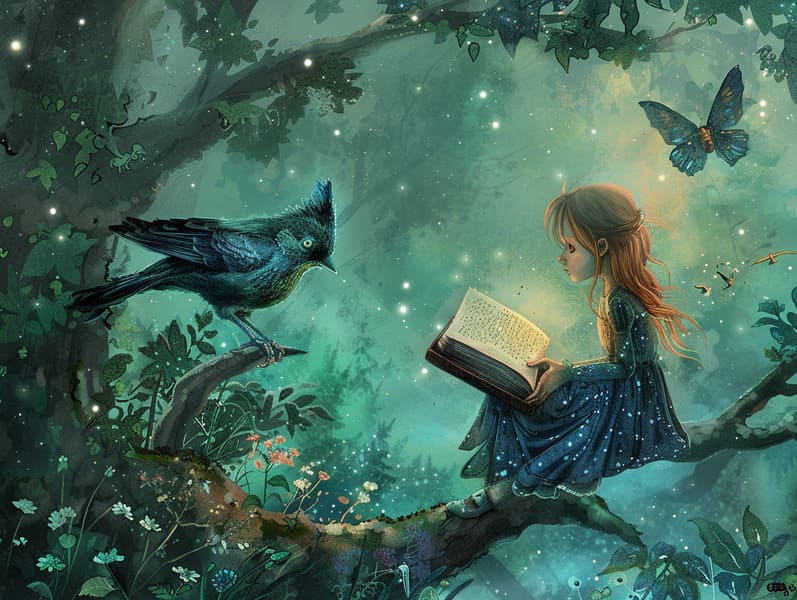
Fairy tales have historical significance. These stories have been relayed from one generation to the next far before they were ever inscribed. They originated from a variety of backgrounds, including Middle Eastern traditions. They were initially conveyed among grown-ups, often carrying themes and messages concerning the societal norms and beliefs of the time.
The Grimm brothers, Jacob and Wilhelm (the Grimm brothers), were among the first to collect and release many of these beloved fairy tales. Their anthology, "Grimm's Children's Stories," included narratives like "Ashenputtel," "The Bread Crumb Trail," and "Schneewittchen," which have since become mainstays in the world of iconic fairy tales. Similarly, Hans Andersen's delightful stories, such as "The Mermaid's Tale," and "The Story of the Ugly Duckling," have enchanted hearts worldwide, securing their place in the pantheon of timeless fairy tales.
Though they are old, these stories remain as meaningful as ever, especially as children's night stories. These whimsical stories are now available in diverse formats, including vividly illustrated books, charming animations, and online fairy tales.
Their lasting presence can be linked to several charming aspects:
Ethical Lessons: Ancient fairy tales often impart important moral lessons. Fairy tales like "The Boy Who Cried Wolf" teach the benefit of honesty, while "The Race of the Tortoise and the Hare" illustrate the traits of tenacity and unassuming nature. These stories offer young readers clear distinctions between truth and falsehood, molding their moral compass in a gentle yet profound way.
Empathy and Understanding: Classic fairy tales frequently involve beings facing challenges and problems, fostering children to identify with their struggles and root for their triumphs. For instance, "Beauty's Beast" emphasizes the merit of looking past the exterior to realize the inner spirit of a individual, advancing awareness and recognition.
Cultural Knowledge: Many timeless fairy tales are saturated in the cultural contexts from which they arose. Learning from these tales can provide intriguing perspectives into different social structures, developing a sense of global awareness and acknowledgment.
Fantasy and Innovation: The extraordinary elements in fairy tales—magical beings—provoke children’s innovations. These tales bring readers to magical realms, provoking imaginative thinking and a sense of curiosity that endures a lifetime.
Timeless fairy tales are not only enchanting but also teaching. They provide fantastical tools in nurturing various mind and heart abilities in children. When fairy tales are voiced, they cultivate verbal development by presenting new terms and elaborate sentence structures. This practice also strengthens listening skills and attentiveness, as young readers hang on every word, looking forward to see what happens next.
Furthermore, analyzing the themes and characters of ancient fairy tales can nurture analytical skills and critical thinking. The young are taught to find patterns, expect results, and grasp cause and effect. These examinations also boost little ones reveal their thoughts and feelings, promoting their emotional intelligence.
In today’s modern era, the prevalence of free fairy tales online has made these stories more obtainable than ever. Internet sites and web apps present extensive collections of timeless fairy tales that can be seen or listened through anytime, anywhere. Fairy tales narrated are particularly in demand, featuring an interactive way for children to experience these alluring stories. Voice books and read-out-loud videos lead characters and settings to life, often paired with entrancing background sounds and soundtracks that enrich the narrative journey.
The everlasting appeal of classic fairy tales lies in their ability to modify to modern society while retaining their main lessons. Contemporary renditions of these stories often spotlight more inclusive figures and modern settings, making them pertinent to today’s audience. However, the essential messages of braveness, humanity, and lawfulness remain unchanged, continuing to move audiences of all ages.
Fairy tales also offer a sense of familiarity and comprehensibility. They bestow a structured narrative with a apparent beginning, middle, and end, often winding up with the conclusion of conflicts and the triumph of virtue over wickedness. This dependability can be heartening for children, making known a sense of steadfastness in an inconstant world.
Ancient fairy tales continue to more info enthrall and edify new generations, maintaining their loveliness and value in modern society. As children's night stories, they supply a perfect blend of wonder and wisdom, cultivating moral values, empathy, and creativity. The proliferation of web-based fairy tales and the in demand status of fairy tales spoken ratify that these traditional fairy tales remain attainable to new generations.
By sustaining and communicating these tales, we continue to revere the rich tapestry of tradition and cultural heritage. Whether you are seeing a vibrantly illustrated book, perusing a web-based library, or hearing an spoken story, the attraction of famous fairy tales is always within reach. These fairy tales point out of the immortal presence of stories and its ability to join us across time and space.
Whether you are enjoying a beautifully illustrated book, viewing a digital library, or listening on an read-aloud story, the grace of famous fairy tales is always within reach.
These fairy tales emphasize of the continued influence of storytelling and its ability to unite us across eras and regions, establishing a link that charms and informs alike.